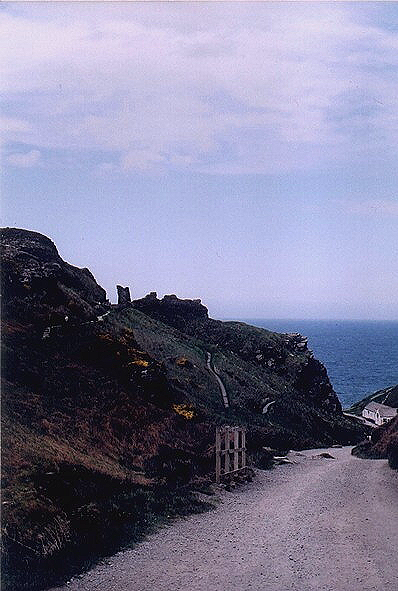 |
The once and future castle |
||
| May 5, 2004 |
||
Someone asked what the high point of my trip to England was. So many things made such an impact, but I suppose if pressed I’d say the most impressive was Tintagel. The place is breathtaking, even if you don't buy into the Arthurian associations—and I'm not sure I do, although recent excavations have produced tantalizing clues that seem to support some Arthurian-era associations. Tintagel village is a little place, heavily influenced these days by the New Age shops, although they haven't gone completely mad with it, thank God, and it still retains some of its village feel. To get to the "castle" (13th century ruins), you have to first go down a long, steep path into a kind of seaside gorge. You can go even further down to the actual rugged beach itself with its spectacular sea-carved caves lining the cliffs, but that's a pretty strenuous climb down then back up and you'd better be prepared to get there early in the day and eat your Wheaties if you want to do both the cliffs and the castle. We wanted to see the castle and then decide about the rest, so we turned away from the sea path and headed towards the "island" on which the castle sits. Once we'd climbed up, then down from the castle we were too tired to climb down (then back up) from the beach. Hell, we were too tired to make that steep climb back out of the gorge. We said, "Screw pride" and paid the enterprising man with the Land Rover to drive us back up again. Actually, the island is a big hunk of rock once linked to the headland by a narrow land bridge. The top of the land bridge has eroded away but the National Trust people have erected a metal bridge for folks to cross over it. It's a steady uphill climb to get to the bridge and the day we were there was moody, gray skies, threatening rain, the wind blowing strong and cold, the sea pounding against the black rocks of the cliffs below and sending up giant spumes. The genuine Daphne du Maurier atmospheric Cornwall experience. Perfect. Once you've wheezed over the bridge (also an upward climb) you still have to scramble up the cliff face to get to the top of the island and the castle. I'm talking very steep steps, chipped out of the rock and then lined with slate—nearly vertical in some places. Okay, okay, okay, so there's a sturdy, multi-layered handrail, but you do feel rather out there on the cliffs. We had to stop for many "photo ops" along the way—our running joke whenever we were seriously out of breath, begun when I actually faked photo ops earlier in the trip so no one would see how winded I’d gotten going up the steep hill at Chysauster. I actually raised the camera to my face for fake pictures, but later confessed what I'd done to much hilarity. Fortunately, we scrambled up so many hills, et al., on this trip that by Tintagel I was in pretty good wind—but it challenged all of us. Was it worth the climb? You betcha. On the island there are layers of ruins: 5th century Dark Age foundations, 9th century monastic ruins, overlaid with the ruins of the 13th century castle. Apparently Richard, Earl of Cornwall, built a castle there as a show piece because even by his day the Arthurian associations at Tintagel were well known. Whenever he had important visitors, he'd send out a legion of workers a week in advance to Tintagel to bring in all the luxurious furnishings and what-not and then take people out there to show off. As soon as the visitors left, he'd remove all the good stuff and leave a small cadre of guards to look after the place most of the year. It was just too windswept and dramatic for a full-time presence. That, more than the ruins, is what makes Tintagel a magic place. Breathtaking—not just from the climb, but from the views along the coastline—black and gold slate rock topped by bright green turf, pounding surf, angry white-capped sea, gulls screaming and gyring. It's just one of those places that makes you vibrate with the raw power of nature. It made me feel insignificant while at the same time making me feel part of the continuum of nature and of the ancestors who struggled to survive in such places. It really did strip away a lot of the modern pretensions because I realized, looking at that untamed coast, that no matter what man builds up, nature has the last word. We can build our show castles, but in some places, it's a constant fight just to stay even. Oh yeah, we have a tendency as a species to try to conquer nature, but we rarely succeed at that long-term. We can destroy a place, change it utterly to suit our short-term needs, but ultimately . . . the rust never sleeps. What was there may not return the way as before we laid our heavy hand on it, but something else will come along that we have to fight against. A place like Tintagel reminds me, if I need it, that humankind is not divorced from nature. We sometimes have the illusion that we are, but nature always has the last word. We can't survive in a world we've destroyed anymore than any other endangered species.
|
||
Copyright © 2010 P.J. Thompson |
